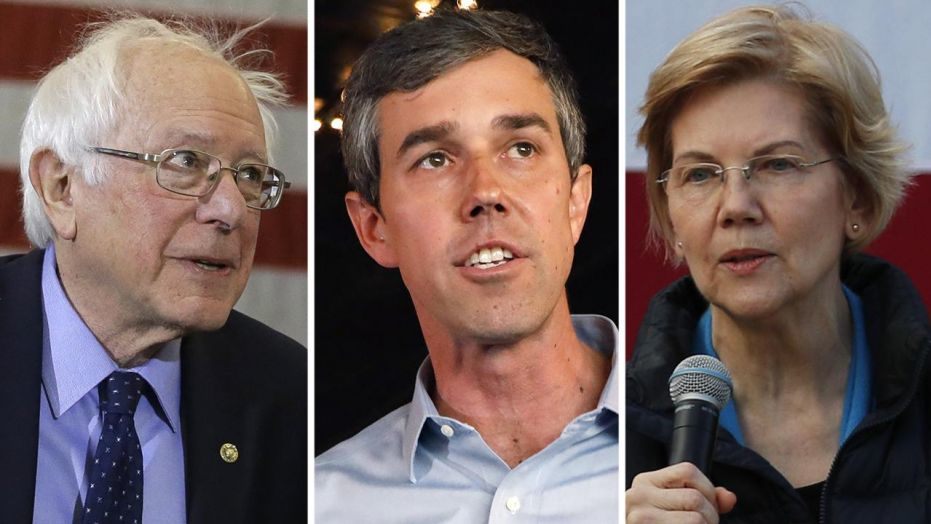Washington Gov. Jay Inslee, little known outside his home state, boasts he raised over $1 million in the days after launching his White House bid. Former Colorado Gov. John Hickenlooper and others say they did, too.
Impressive numbers, even if dwarfed by the $6 million or so reported by Bernie Sanders and now Beto O’Rourke .
The seven-digit figures for the lesser-known Democratic hopefuls don’t lie, but they don’t tell the whole story either. Early bursts of donations don’t happen by accident, especially for candidates with little national name recognition such as Inslee, who hit his target thanks in part to an email list of donors he’s cultivated for months.
He’s among a crowded field of more than a dozen Democrats who are feverishly trying to show they can raise big money and realistically challenge Republican President Donald Trump. With the first-quarter fundraising deadline looming, some are straining credulity to give the impression of a spontaneous groundswell of support.
In addition to Inslee and Hickenlooper, Minnesota Sen. Amy Klobuchar and California Sen. Kamala Harris have boasted they raised $1 million or more in the hours and days after launching their campaigns.
What that signifies is less clear.
“It’s a strange goal post for viability, and there are a lot of tricks you can use to come up with that number,” said Tim Lim, a Democratic strategist who worked for Hillary Clinton’s and Barack Obama’s campaigns. However, he added: “It’s a great talking point.”
So how do you get to $1 million within 24, 48 or 72 hours?
Candidates like Vermont Sen. Sanders and former Texas Rep. O’Rourke have used their star power to quickly raise astronomical sums. O’Rourke announced on Monday that he edged Sanders by pulling in $6.1 million in the 24 hours after his launch.
But a wide range of tools are available to help the lesser-known White House hopefuls.
They include rented fundraisings email lists, targeted social media ads (which all candidates use) and revenue sharing agreements, which allow interest groups to raise money for their own causes while splitting it with a favorite candidate. Fundraising commitments are often lined up in advance, while creative accounting maneuvers can be used to pad the bottom line.
Senators have a leg up. They can take money from existing federal campaign accounts, while governors are largely barred from doing the same with their state accounts.
Before his early March launch, Inslee spent months running targeted ads that asked Facebook users to fork over their email addresses to join his fight against climate change — now the signature issue of his campaign. At the same time, Inslee, who was then head of the Democratic Governors Association, made prospecting trips to states including New York and California.
He started collecting larger checks from conventional donors in the weeks before the launch. Then, shortly after announcing his run, his campaign blasted out thousands of fundraising emails and the online money started to roll in, which he juiced by making rounds on the talk show circuit.
Within about three days, he reached the magic $1 million figure — and his campaign issued a news release.
The fundraising effort was described by two Inslee aides who insisted on anonymity in order to discuss the inner workings of his campaign.
Michael Duncan, a Republican digital strategist, said numbers posted by lesser-known candidates are likely to be less grassroots and more “the campaign equivalent of AstroTurf.” But Duncan, who formerly handled digital strategy for the insurgent tea party group FreedomWorks, said it was a shrewd tactic. Particularly now that the Democratic National Committee is using online fundraising, with an emphasis on low-dollar contributions spread out across many donors to qualify for the debate stage.
“I would imagine the grassroots support is manufactured,” said Duncan, who also was an architect of Israeli Prime Minister Benjamin Netanyahu’s digital strategy in 2015. “I’d doubt they’d own a file of hundreds of thousands of Americans dying to give them $10.”
Most campaigns won’t offer specifics on how they reached their mark. News releases sent out at the time shed some light, however.
Harris offered the most detail. Her campaign announced in January that it raised $1.5 million in 24 hours, collecting an average donation of $37 from more than 38,000 people.
From there, it gets more fuzzy.
Klobuchar’s campaign said it raised $1 million in 48 hours from “online and grassroots” supporters in all states, but did not break the numbers down further. Inslee launched his campaign on a Friday and announced the following Monday that he had reached the mark, with donations coming from all 50 states.
Hickenlooper’s campaign said it reached the figure in less than 48 hours and received donations from all 50.
His campaign wouldn’t offer specifics. But touting the number was a no-brainer, said spokeswoman Lauren Hitt.
“Of course we thought it was important in our launch to show he is the more-than-viable candidate we know,” she said.
Though $1 million is a lot to most, raising that much isn’t as difficult as it may seem. It could be reached if about 357 donors cut checks for the $2,800 primary maximum. And lining up support from longtime donors in advance could go a long way toward getting a candidate close.
Zac Moffatt, Mitt Romney’s 2012 digital director, said the focus now will be whether they can keep it up.
“The question would be: what is Act II?” he said.
(AP)











